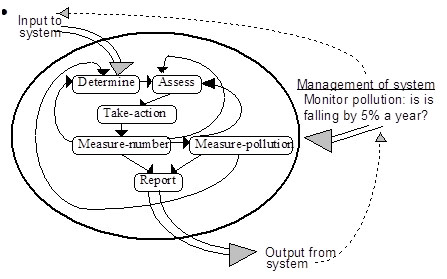Step 4: Conceptual Models
Deriving a conceptual model is a method of analyzing the activities which need to take place in order to clearly define what the actors need to do in order to achieve the transformation. Do not include activities performed by anyone other than the actors whom you have named in the root definition (and if possible, limit the actors to one group of people – activity-monitoring becomes very complicated when more than one group are involved). Again, disciplined thinking is required – list the activities needed to achieve the objectives of the system. It is important also to include activities which monitor the system and feed-back results, so that system activities may be performed effectively. Ask: what defines success for this system? how can I measure that success? what do my actors need to do, to measure success?
I have chosen to provide a conceptual model for transformation (7), in the two examples below. The Root Definition for this system is:
A system owned by Local Government Administration, where a combination of parking restrictions, to alleviate congestion at bottlenecks, and public transport provision, to make driving less attractive for short journeys, reduces the number of cars on the road and so improves air quality and traffic flow on major routes.
The list of activities which I perceive as necessary for this transformation are:
1. Determine the extent of the problem (congestion & emissions), by major traffic route
2. Assess potential impact on these factors by managing parking, or implementing public transport
3. Take those actions that produce these impacts
4. Measure the number of people who transfer from cars to public transport
5. Measure the impact upon the environment of that transfer
6. Report to the public on the results.
In Figures 4-1 and 4-2, I contrast a weak attempt at a conceptual model with a strong(er) attempt, for Transformation 7: Traffic congestion causes high C02 & particulate emissions ⟶ Easy and convenient public transport replaces need for short car journeys on local routes.

The conceptual model shown in Figure 4-1 would be considered weak because each activity in the conceptual model is defined minimally. The activity defines what is to be done (the basic steps of the transformation), but not how to do it so that the purpose of the transformation (the combination of transformation, worldview/rationale, and evaluation of outcomes is achieved. Even the evaluation of the subsystem of activity is minimal, using only a single indicator to evaluate success.has fallen into the “consultancy mode” trap. What I have defined here is not what needs to be done, but how I, as a consultant, intend to find out what needs to be done and then take action. This happens whenever you do not have sufficient information from the stakeholders about what actually needs to be done – so you fudge the set of requisite activities! This is a core part of the “appreciating the situation” work of step 1.
As part of the step 1 analysis, you need to interview as many stakeholders as you can, to gather perspectives and to understand what they would like to happen – and why this system-purpose is important to them. This is often an iterative process: you define a transformation from one perspective, explore what needs to be done to achieve it , then realize that you need more information from stakeholders to understand the “hows” and “whys” of these activities. Having iterated a couple of time, you can then define a much more informed – and feasible conceptual model, as shown in Figure 4-2.
Let us imagine that I have done this – and the core stakeholders suggested two main strategies for achieving transformation (7):
– Increase fines for driving offenses and cross-subsidize public transport with the revenue raised.
– Make driving more difficult and time-consuming than public transport by rationing road use and policing parking at bottlenecks.

This conceptual model shown in Figure 4-2 is stronger, as it defines activities in terms of what needs to be done, and how, to achieve the desired purpose of the transformation. Each activity is defined from the worldview of why this transformation is important to the success of the system as a whole (of which it reflects one perspective). At each stage of the sequence of activity, evaluation criteria are considered – for example, when cost-benefit analyses are used to prioritize traffic routes for change implementation. This analysis of activities produces multiple indicators by which we can evaluate success, which allows us to tweak both activities and success criteria, on each cycle around the steps of this subsystem (which would be repeated multiple times, over the duration of the change project).
An important element of conceptual models are the feedback loops. There are normally two feedback loops in any conceptual model:
1. An internal feedback loop, that permits actors involved in the human-activity system perspective modeled to adjust how they perform their work (in this case, this loop is between the first and last “Measure traffic flows, congestion-points, CO2 and particulate emissions, in key places along each route” activities, enabling the state of the system at the start of the activity to be compared to the state of the system at the end of this round of activity). This feedback loop (the dotted line inside the model boundary) permits the people doing the work to evaluate their performance.
2. An external feedback loop, between the inputs and the outputs of the activity system model for this perspective. This feedback loop (the heavier dotted line outside of the model boundary) permits external managers to evaluate the performance of the system from this perspective. To permit the effective management of any system, you need to define measures of success for each transformation-purpose of the system. There is rarely a single measure that will indicate success – instead, use compound measures to evaluate complex outcomes – as shown to the right of the conceptual model in Figure 4-2.
